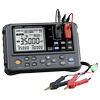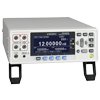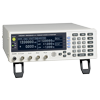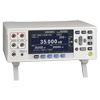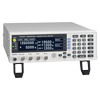How to measure low resistance accurately with a resistance meter
QWhat should I pay attention to if I want to measure low resistance more accurately and precisely? (Resistance Meter RM3544)
A
For low-resistance measurements, there are six factors that are considered to affect the measured value. Each of these can be minimised.
| 1. Wiring resistance and contact resistance | In particular, when measuring low resistance, the wiring (measuring lead) used in resistance measurement generally causes measurement errors due to the resistance of the wiring itself and contact resistance. To eliminate the effects of wiring resistance and contact resistance and to make accurate measurements, use 4-terminal measurements.
- Contact Resistance |
| 2. Thermoelectromotive force | Thermoelectromotive force is a small voltage generated at the point of contact between dissimilar metals. In resistance measurement, thermal electromotive force is generated at the point of contact between "probe - sample" and "probe - instrument". Also, the value varies depending on the type of metal and environmental temperature. In the case of the DC resistance meter using the I-V method (*1), the thermal electromotive force affects the measurement value and causes measurement errors. In order to eliminate the influence of thermal EMF, metals with low thermal EMF should be in contact with each other as much as possible, or the OVC function (*2) of the resistance meter should be used for simplicity.
The AC resistance meter can be used to measure without the influence of thermal electromotive force due to its measurement principle.
|
| 3. Leakage current | When measuring high resistance, use a dedicated shielded measuring cable to guard against it. In this way, the leakage current will flow through the shield and not pass through the current detection circuit in the instrument, so the effect of the leakage current will not appear in the measured value. |
| 4. Pay attention to the characteristics of the device | When measuring magnetoresistive elements (contacts, MR elements, chip inductors, etc.), care must be taken not to damage the characteristics of the device. If a contact point, MR element or chip inductor is measured with a relatively large current, it may change the characteristics of the measuring object or damage its characteristics.
-- Influence example -- |
| 5. External noise | External noise from electromagnetic fields such as those emitted by fluorescent lamps and motors can cause instability in the measured values. Fluorescent lamps and commercial power lines are electrostatically coupled to the measuring leads and affect the measurement results, especially in high resistance measurements with low detection current. The effect of external noise due to electrostatic coupling can be reduced by shielding the measuring leads. The magnetic field radiated from a transformer or similar device is magnetically coupled to the measuring leads, resulting in extraneous noise. External noise due to magnetic coupling can be reduced by making the loop of the measuring lead as small as possible or by moving the measuring lead away from the source of the magnetic field. |
| 6. Temperature changes | A relatively large change in ambient temperature will cause the readings to fluctuate, resulting in a measurement error. Please use the instrument within the guaranteed temperature range. If the instrument is used in an environment outside the guaranteed temperature range, the accuracy range should be multiplied by the specified temperature coefficient. The temperature coefficient is described in the instruction manual attached with the product. |
In addition, refer to the "Resistance Measurement Handbook" document.
https://www.hioki.com/us-en/support/download/guides?keyword=RM3545

